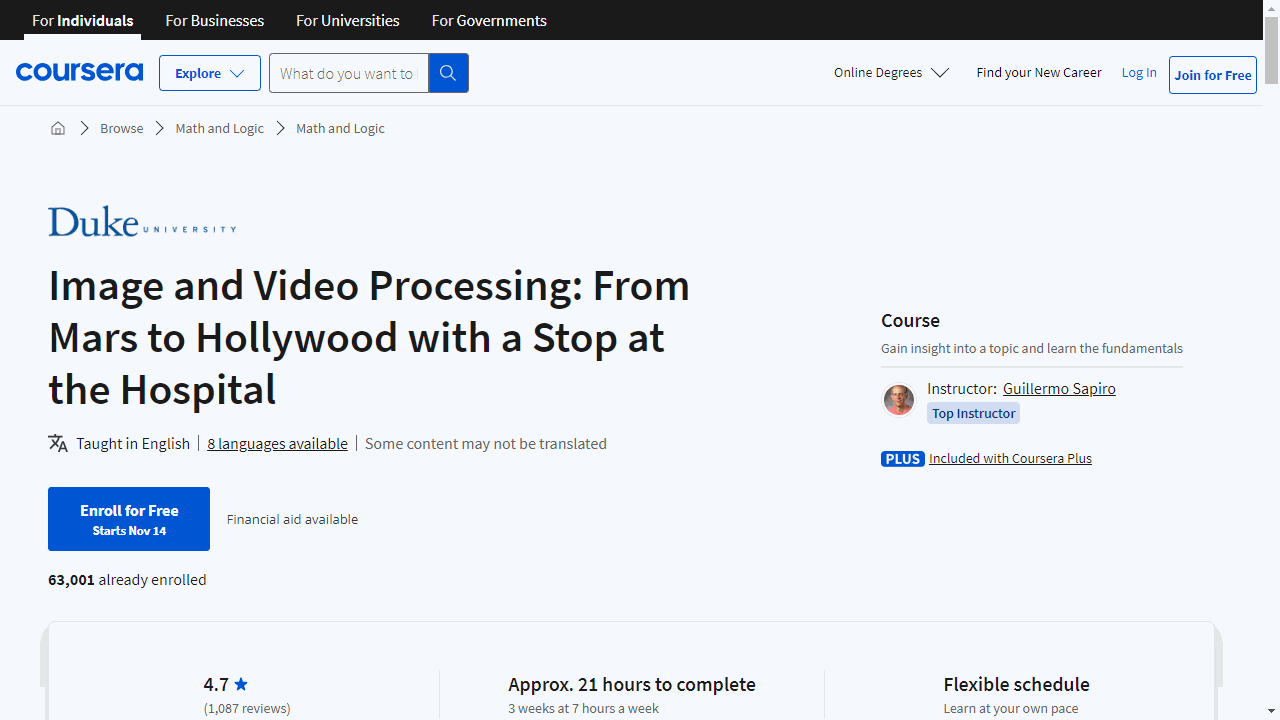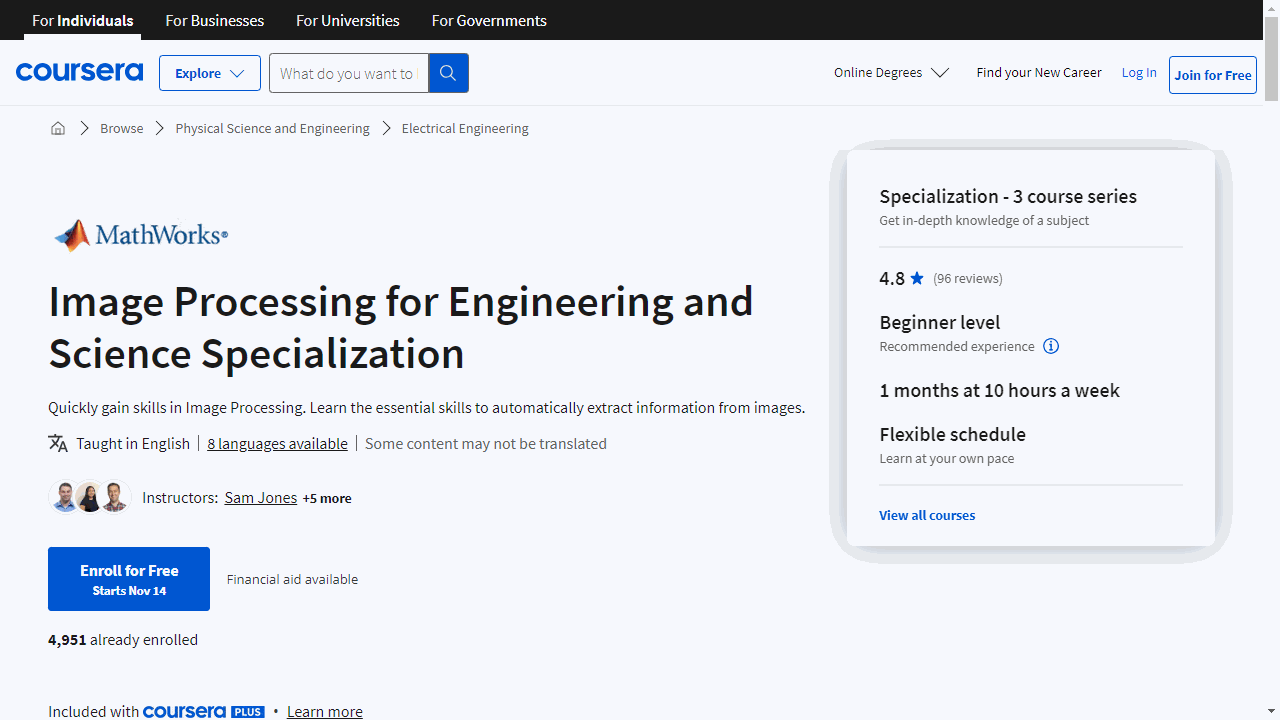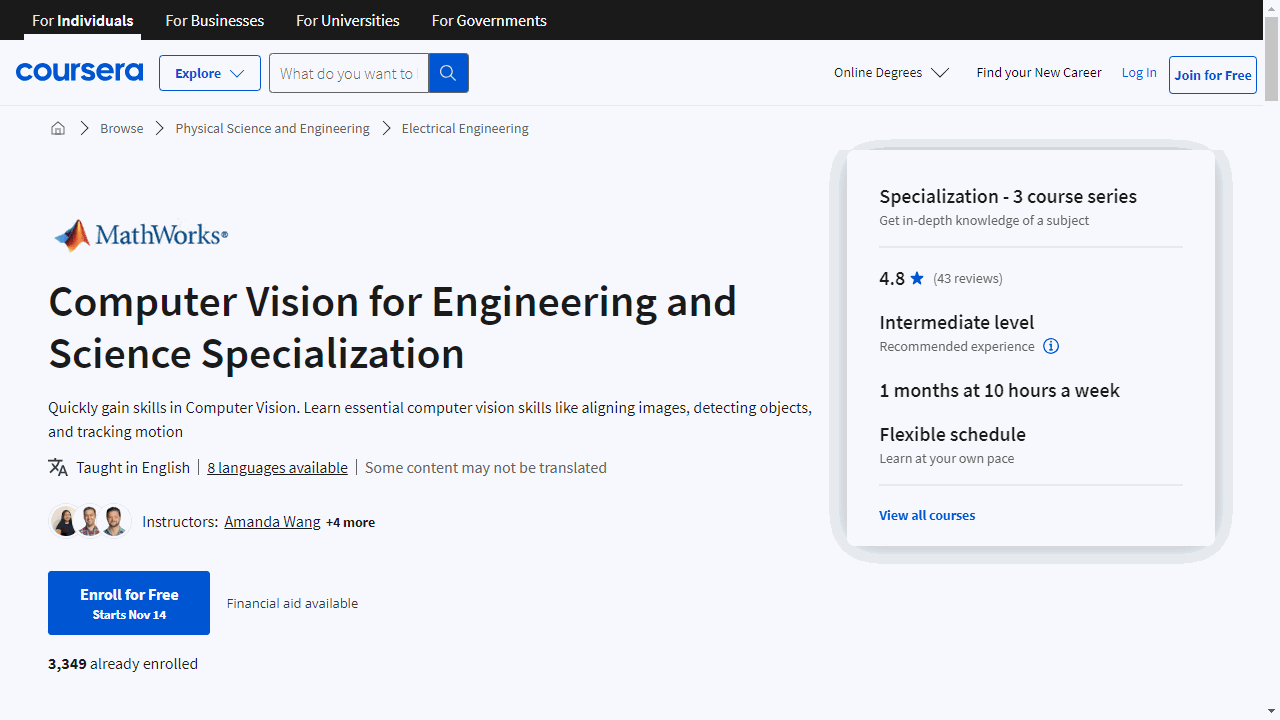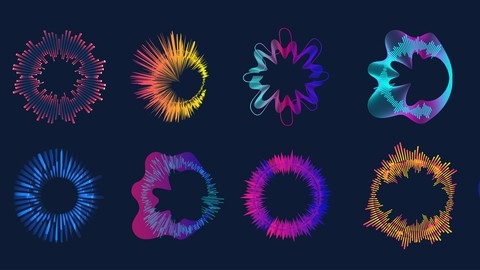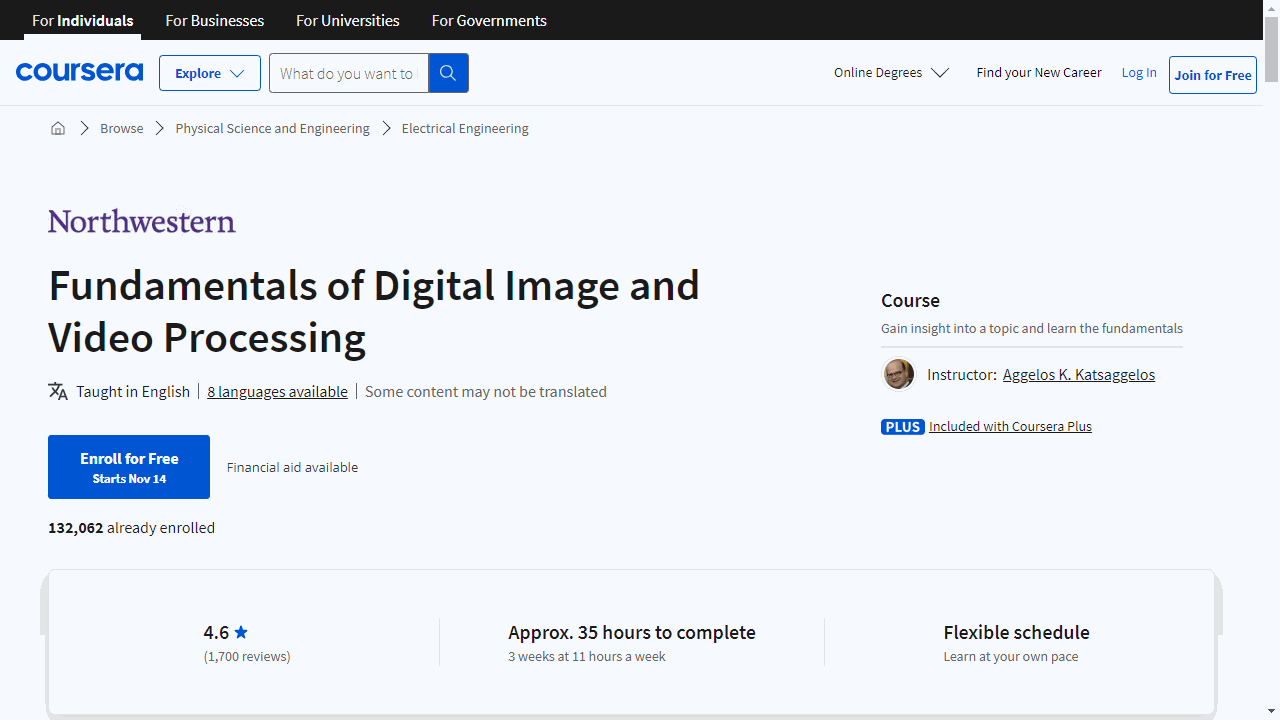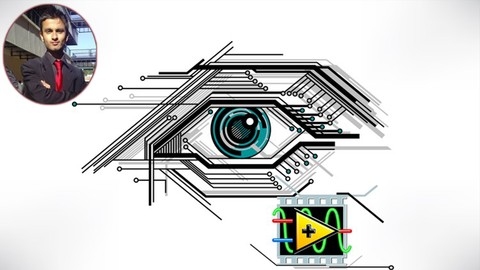Image and video processing are fundamental fields in computer science and engineering, impacting everything from medical diagnoses to special effects in movies.
By understanding these technologies, you can unlock the ability to analyze, enhance, and manipulate images and videos, opening doors to careers in diverse fields like healthcare, entertainment, and robotics.
Whether you’re interested in improving medical image quality, developing computer vision algorithms, or creating stunning visual effects, mastering image and video processing is a valuable asset.
However, finding a comprehensive and engaging course that covers the breadth and depth of this field can be challenging.
You want a course that’s both theoretically sound and practically oriented, taught by experts, and relevant to real-world applications.
For the best image and video processing course overall, we recommend Image and Video Processing: From Mars to Hollywood with a Stop at the Hospital offered on Coursera.
This course provides a comprehensive overview of the field, covering topics from basic image formation to advanced techniques like PDEs and sparse modeling.
Its wide range of applications, including medical imaging, makes it a great choice for learners with diverse interests.
While this is our top pick, there are other great options available depending on your specific needs and learning preferences.
Keep reading to discover more recommendations for both beginners and experienced learners, including courses focused on specific software tools and applications.
Image and Video Processing: From Mars to Hollywood with a Stop at the Hospital
Provider: Coursera
This course on image and video processing will teach you how images are formed, represented digitally, and compressed.
You will learn about JPEG, a common image format, and how compression techniques make file sizes smaller.
You will then discover image enhancement, learning techniques like histogram equalization and median filtering to improve image quality by adjusting brightness, contrast, and sharpness and reducing noise.
You will also explore image restoration, learning how to fix images that are blurry or have other imperfections.
Techniques like Wiener filtering and noise estimation will help you remove noise from images and bring back lost information.
Image segmentation will be another skill you learn, allowing you to divide an image into different regions based on specific features.
Using techniques like the Hough Transform and Otsu’s method, you’ll be able to identify edges and regions within images.
This course also delves into advanced concepts like partial differential equations (PDEs) used in image processing tasks like inpainting.
You will learn how to fill in missing parts of an image and discover how PDEs can be used for enhancing contrast and creating cool effects.
You’ll even learn about sparse modeling, a powerful technique for representing images efficiently, and see how it can be used for tasks like image denoising and compression.
The course also highlights how image processing is applied in medical imaging.
You will learn about its impact in fields like HIV research and brain imaging.
Learn MATLAB with Image Processing from scratch!
Provider: Udemy
This Udemy course teaches you the core ideas of image processing with MATLAB, even if you’re brand new to the topic.
You start by learning the basics of MATLAB and its image processing tools.
You’ll then discover how to work with images and videos, including changing them between color spaces like RGB and HSV.
The course then guides you through image histograms, showing you how to adjust them to make images clearer.
You will explore key image manipulation techniques, including smoothing to reduce noise and blur images.
You’ll then learn how to find edges in images, a crucial part of image processing.
You’ll implement different edge detectors and even discover techniques for sharpening images.
You will then dive into the world of noise reduction, learning how to deal with different types of noise.
The course also explores Morphological Image Processing, where you’ll learn how to change the shapes of objects in images.
Finally, you’ll get to apply everything you’ve learned in hands-on projects, such as identifying faces in pictures and creating cool vintage effects.
This practical experience will help you build a portfolio and show off your new image processing abilities.
Image Processing for Engineering and Science Specialization
Provider: Coursera
This Coursera specialization on Image Processing for Engineering and Science is a great starting point if you’re new to the field.
You’ll begin by learning the basics of digital images, like how to work with their size and orientation, and how computers interpret them.
You will discover how to identify specific areas within images, a process known as image segmentation.
For instance, you will learn to determine the extent of surface water from satellite images.
As you progress, you’ll explore more complex techniques, such as using spatial filters to eliminate noise from images and employing methods like edge detection and clustering for image segmentation.
You will also gain an understanding of analyzing specific regions of interest within images.
A practical example of this is segmenting an MRI image of a brain to differentiate various tissues.
Finally, you’ll learn how to apply image processing techniques on a larger scale, like analyzing video files and detecting objects in them.
You will even work on a project where you’ll need to identify cars in a video with visual disturbances, giving you practical experience in using these techniques.
Throughout this specialization, you’ll utilize MATLAB, a software extensively used in engineering and science.
Don’t worry if you haven’t used MATLAB before, as you’ll be provided with free access and guidance.
Complete Python Based Image Processing and Computer Vision
Provider: Udemy
This course begins by teaching you how to manipulate images using Python.
You’ll discover how to resize, transform, and even filter images, gaining a solid understanding of interpolation and contrast stretching along the way.
These fundamental skills prepare you for the exciting field of computer vision.
You’ll then dive into computer vision using OpenCV, learning how to use this library to find edges in images, detect corners, and even recognize faces using Haar features.
As you progress, you’ll explore the world of machine learning, starting with unsupervised learning techniques.
You will learn how to use methods like PCA and K-means to uncover hidden patterns in image data, applying PCA for image reconstruction and t-SNE to classify complex datasets.
The course then introduces supervised learning, teaching you how to use powerful algorithms like Support Vector Machines (SVMs) and Random Forests to categorize images.
You’ll gain practical experience by working with real-world datasets, learning how to train models to classify handwritten digits.
Next, you’ll explore the cutting-edge field of deep learning, where you’ll build Convolutional Neural Networks (CNNs) using TensorFlow and Keras.
You’ll master the art of image classification, learning about activation functions, pre-processing techniques, and how to construct effective CNN models.
You’ll even delve into the world of transfer learning, leveraging the power of pre-trained models like InceptionV3 to enhance your own image recognition tasks.
Finally, you’ll explore unsupervised deep learning, discovering how autoencoders can be used for tasks like image reconstruction.
The course also introduces you to essential tools for any aspiring computer vision practitioner, including GitHub, Google Colab, and Google Cloud Platform (GCP).
Computer Vision for Engineering and Science Specialization
Provider: Coursera
This Coursera specialization equips you with the skills to analyze images using computer programs.
It’s structured as a three-course series where you gain hands-on experience using MATLAB, a popular software in engineering and science.
You learn to identify and match features in images, a skill used for tasks like aligning satellite images or creating panoramic views.
This also allows you to align images taken at different times or from different instruments, crucial in medicine and remote sensing.
You then explore machine learning for computer vision, learning to train computers to understand images.
You’ll tackle image classification, determining the type of image, and object detection, finding specific objects within an image.
This involves the complete machine learning process from data preparation to result evaluation.
You’ll apply your skills by training models to identify street signs and detect material defects.
Finally, you delve into the challenging world of tracking moving objects and detecting motion in videos, used in autonomous vehicles and medical imaging.
You’ll leverage pre-trained deep neural networks for object detection, combined with techniques like optical flow, to detect motion and track objects.
This culminates in a project where you create a system to track cars on a highway, counting them and determining their direction.
Python Digital Image Processing From Ground Up™
Provider: Udemy
This course guides you from the basics of Python to becoming comfortable working with images using code.
You will begin by setting up your Python environment.
You will then build a strong foundation in Python programming, covering variables, lists, loops, and functions.
This foundation in Python is essential for you to dive into the world of digital image processing.
The course then introduces you to essential image processing concepts, such as image formats, color, resolution, and popular libraries like OpenCV and the Python Imaging Library (PIL).
You will gain hands-on experience with image manipulation techniques, learning how to adjust brightness, contrast, and color.
You will explore histograms and learn to use histogram equalization for better visual clarity.
You’ll become skilled in geometric operations, enabling you to translate, rotate, and scale images.
You will then learn about image enhancement techniques, including filter kernels, gamma correction, and gray-level transformations.
You will master neighborhood processing and convolution, essential for blurring, sharpening, and noise reduction.
Edge detection, a fundamental technique used in computer vision, is also covered in detail.
You will learn to identify boundaries in images using methods like Prewitt, Sobel, and Laplacian operators.
The course even covers how images are formed, combining practical coding with the mathematical principles behind it.
You can even learn to set up a Raspberry Pi and use it for image processing tasks.
Fundamentals of Digital Image and Video Processing
Provider: Coursera
This course takes you on a journey through the fascinating world of digital image and video processing.
You begin by exploring the foundation of image and video signals, understanding how they differ from their analog counterparts and how they are represented in the electromagnetic spectrum.
You delve into the mathematical representation of images and videos as 2D and 3D discrete signals and explore the power of complex exponential signals in signal processing.
You then learn how to manipulate these signals using linear shift-invariant systems.
You master the art of convolution, a fundamental operation in image processing, and apply it to filter images in both spatial and frequency domains.
You develop a deep understanding of the 2D Fourier transform, allowing you to analyze and manipulate images based on their frequency components.
You explore techniques like phase correlation and block matching, gaining valuable skills in motion estimation.
The course then unveils the secrets of color image processing.
You discover various techniques like point-wise intensity transformations to adjust image brightness and contrast, histogram processing to enhance image details, and different noise smoothing and sharpening methods to improve image quality.
You learn about homomorphic filtering, a powerful technique to manipulate illumination and reflectance separately, and explore the art of pseudo-coloring, where you assign colors to grayscale images to highlight specific features.
Finally, you enter the realm of image and video compression.
You delve into the principles of information theory, understanding how data redundancy is exploited to compress images and videos efficiently.
You explore various coding techniques, including Huffman coding, run-length coding, arithmetic coding, and dictionary techniques, understanding their strengths and limitations.
You learn how these techniques form the foundation of popular compression standards like JPEG for images and H.261, H.263, MPEG-1, MPEG-2, MPEG-4, H.264, and H.265 for videos.
You gain insight into motion-compensated hybrid video encoding, a technique that drastically reduces data redundancy in video sequences by exploiting temporal correlations.
Learn Computer Vision and Image Processing in LabVIEW
Provider: Udemy
This course is a practical and engaging way to learn image processing and computer vision using LabVIEW.
You will start by building a strong foundation in the fundamentals, understanding the differences between computer vision and machine vision, and getting familiar with LabVIEW’s Vision Development Module.
You will then delve into color processing, learning how computers interpret color and how to use this knowledge to build applications.
Imagine being able to count M&Ms in an image based on their color or track the movement of a colored object in real time – this course gives you the skills to do just that.
You will also explore feature detection, learning how to identify edges, lines, and patterns in images.
This is where things get really interesting, as you will build applications to detect coins, measure objects using a caliper tool, and even create a basic lane detection system, a core component of self-driving cars.
As you progress, you will master advanced techniques like template matching, optical flow, barcode recognition, and OCR.
You will apply these techniques to build even more sophisticated applications, such as pattern recognition systems, real-time object trackers, barcode scanners, and even your own OCR system to extract text from images.
The course doesn’t just stop at teaching you the techniques; it empowers you to create real-world applications.
Also check our posts on:
